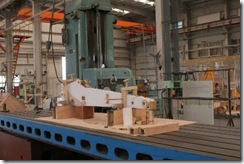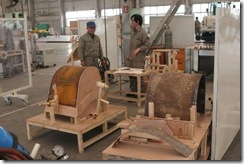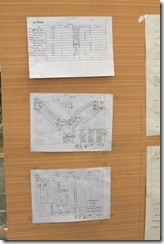I would like to thank everybody for a really engaging dialog in the previous two posts about 5S audits.
Now I would like to dig in and look at what an “audit” is actually finding, and how we are responding to those issues.
Our hypothetical production area is getting an audit. The checklist says things like “There are no unnecessary items in the work area” and “There is a location indicated for all items.”
If there are unnecessary things in the work area, or things are not in their designated locations, what happens?
Of course, the checklist is filled out and a score is assigned.
But what has been learned about the process?
In one of the comments, I asked something like “When was the problem first noticed?”
The core purpose of 5S is to establish a testable condition that asks the question: “Does the team member have everything he needs, and nothing he doesn’t, where he needs it, when he needs it, to carry out his process as we understand it?”
One of the primary purposes of marking out the locations is to indicate the standard so that someone can notice right away that the standard has been broken. What should happen right then and there?
Since we define a “problem” as “any departure from the standard or specification,” and we have taken the first step of removing ambiguity from the situation (by deciding what should be here, and marking it out), we want an immediate response to the problem.
Ideally this means that the team member would indicate trouble (andon call, or other means) as soon as he discovered that his air gun was missing, or didn’t work.
The back-up to this is the team leader’s standard work. His eyes should be scanning for situations where there is a problem that the team member hasn’t called out. This is why the standards are marked out, posted, etc. To make this job easy for him. His immediate response would be to (1) Seek to understand the situation – what pulled the team member off his standard work, where did the problem originate, (2) Correct the situation. Sometimes that’s it. Other times, there is another problem to dig into.
It could be that something about the work process or conditions has changed and the team member is improvising a bit. That would bring extra stuff into the area, for example. I recall a great example where we pulled all of the thread cutting tools out of assembly so we could better detect when assembly was getting defective fabricated parts. It worked by forcing the process to stop and an andon call since assembly could not proceed if the threads were not cut.
At the same time, if a thread cutter found its way back into the assembly area, we would know we had two problems. First, we had defective parts. But more important, the process of telling us about that problem had been bypassed.
The back-up to the team leader’s standard work is the supervisor’s standard work. She is looking two levels down, but her response is going to be different. Unless safety or quality is jeopardized, the supervisor is going to find the team leader and (1) Seek to understand what pulled the team leader off of his standard work, and (2) correct the situation.
If the next level up is spending any time at all out on the shop floor, it is the same thing – maybe once a day – seeking out verifiable evidence that things are working as they should be. In the lack of positive evidence of control, we must assume there are hidden problems.
Now, if the audit finds something like this (click on the image for a bigger one):
 Then it isn’t about the tape being out of place, nor is it a question about where the screwdriver is. What we have discovered is that none of the checks have been made, or if they have, no one has done anything about them.
Then it isn’t about the tape being out of place, nor is it a question about where the screwdriver is. What we have discovered is that none of the checks have been made, or if they have, no one has done anything about them.
Someone said “If we don’t do audits then 5S deteriorates.” OK – but why does 5S deteriorate?
Simply put, it is going to deteriorate, just as your process does, a little bit every day. Disorder is always being injected into everything. Your process will never, ever be stable on its own. No matter how good you are, the next level of granularity will show up as deterioration.
This is the “chatter” that Steven Spear talks about.
The question comes down to your core intention for the audit.
If you are assessing how well the area manager is coaching and teaching his people to see and respond to problems so that you can establish a target condition for his learning, and then develop his capabilities accordingly… there are better ways (in my opinion) to do that.
If you are assigning a numeric score in the hope that, by measuring something you can influence behavior, it might work, but people can come up with ingeniously destructive ways to achieve the numeric goals. As a thought experiment – how might an area manager get a high score on his 5S audit in ways that run completely counter to the goals of 5S, people development or “lean?”
The bottom line is that “Audit 5S” is not something that you should accept as a given. Rather, it is a proposed countermeasure to some problem. But if you start with a clear problem statement like “Team members are bringing thread taps into the assembly line,” and start asking “Why” five times, get to a root cause to that problem, you are unlikely to arrive at a monthly or periodic 5S audit as a countermeasure – nor are you ever going to need one.
The problem?
I think we feel the need to do audits because we have no process to immediately detect, correct and solve the little problems that happen every day. These little issues are the ones that cause the 5S erosion. Because we don’t have a process to deal with them one-by-one, we have to have an elaborate process that disrupts our normal work flow and takes them on in big batches.
Does that sound like a “lean” process to you?
How might we relentlessly drive the “audit” process closer to the ideal of one-by-one confirmation?
That would be “lean thinking.”






